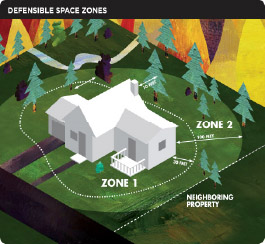It is possible to use less water in your yard and still safeguard your property from wildfires.
Firescaping is landscape design that reduces house and property vulnerability to wildfires. The goal is to develop a landscape with a design and choice of plants that offers the best defensible space and enhance your property by surrounding your house with plants that are less likely to burn.
Plan a fire-resistant landscape
- Plan a “leaner palette,” with open space and less-crowded vegetation.
- Reduce fuel by replacing oily plants (such as junipers) with fire-resistant plants. Many are also drought-tolerant. (See below).
- Create “islands” of vegetation separated by permeable hardscape such as pebble pathways, which also help with runoff.
- Capture rainwater and use drip irrigation at night or early morning to reduce evaporation.
- Reach out to a local nursery or your local fire agency for plans and concepts.
Prepare a defensible space
- Clear out flammable and dead vegetation at least 30 feet from structures. Check with your local fire agency for the exact distances required in your area. Use inorganic materials such as gravel for mulch.
- Remove dead branches, grass, weeds and palm fronds, and thin out dense growth under bushes, ivy, and shrubs.
- Mow brown or dead turf to less than three inches. Better yet, replace it with fire-resistant ground cover.
- Trim tree branches to more than 6-10 feet above structures. Trim canopies so they do not touch.
Preserve & maintain your yard
- Perform regular maintenance of your landscaping once or twice per month.
- Landscapes are not static. Clear out thick growth, fallen leaves and branches, dead plants, and weeds.
- Use appropriate plants in the right locations, and water accordingly.
Additional Resources
Each Texas community is unique. Contact your local nursery, cooperative extension, or fire agency to determine the best plants and for landscaping tips in your area.
Defensible Space Zones
 Zone 1 extends 30 feet (check local ordinances) out from structures.
Zone 1 extends 30 feet (check local ordinances) out from structures.
- Remove all dead vegetation from your yard, roof and rain gutters.
- Trim trees regularly to keep branches 10 feet from other trees and 10 feet away from your roof.
- Remove or prune flammable plants and shrubs near windows, and items that could catch fire from around house and under decks.
Zone 2 extends another 70 feet.
- Mow grass to four inches (three if it’s brown).
- Create horizontal and vertical space between shrubs, grass, and trees.
- Remove leaves, needles, twigs, bark, cones, and small branches.
Fire-Resistant Plants
Check your local nursery, landscape contractor or county extension service for advice on fire-resistant plants that are suited for your environment, and for help to plan your landscape. They include the following:
- hedging roses
- bush honeysuckles
- currant
- cotoneaster
- sumac
- coreopsis
- yellow iceplant
- French lavender
- red monkey flower
Prepare Your Home
Creating and maintaining defensible space is an essential first step to increasing your home’s chances of surviving a wildfire. Protecting your home from flying embers is the next step.
- Clear leaves and other debris from gutters, eaves, porches and decks. This prevents embers from igniting your home.
- Cover vent openings with 1-8-in. to 1/4-in. metal mesh. Do not use fiberglass or plastic mesh because they can melt and burn.
- Remove combustible materials from underneath decks and clear trash, wood, and other flammable materials at least five feet away from the house and garage.
